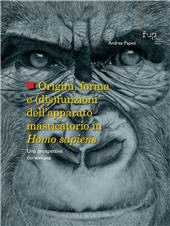Origini, forma e (dis)funzioni dell'apparato masticatorio in Homo sapiens : una prospettiva darwiniana
504 p. : ill.
Includes bibliographical references and index.
La struttura anatomo-funzionale di cui è dotato oggi l'essere umano affonda le sue radici nella nostra storia evolutiva: conoscere quest'ultima ci aiuta a capire perché il nostro corpo abbia questo aspetto e funzioni in questo modo. Ogni essere vivente, "Homo sapiens" compreso, è il risultato di una progressiva stratificazione di forme adattatesi alle pressioni ambientali che dal tempo profondo fino a oggi ne hanno plasmato la morfologia. Il nostro apparato masticatorio (evolutivamente molto recente) iniziò a svilupparsi con l'avvento dei mammiferi circa 250 milioni di anni fa, strutturandosi con una morfologia e una funzione uniche, strettamente legate alla postura eretta tipica del genere "Homo" e alla encefalizzazione globulare, peculiarità caratterizzante "Homo sapiens". [Testo dell'editore]
The anatomical-functional structure with which human beings are equipped today has its roots in our evolutionary history: knowing the latter helps us understand why our body looks like this and functions in this way. Every living being, including "Homo sapiens", is the result of a progressive stratification of forms that have adapted to environmental pressures which have shaped their morphology from deep time until today. Our masticatory apparatus (evolutionarily very recent) began to develop with the advent of mammals around 250 million years ago, structuring itself with a unique morphology and function, closely linked to the upright posture typical of the "Homo" genus and to globular encephalisation, a characterizing peculiarity "Homo sapiens". [Publishe'rs text]
-
Informationen
ISBN: 9791221502602
REIHE
THEMENBEREICHE


